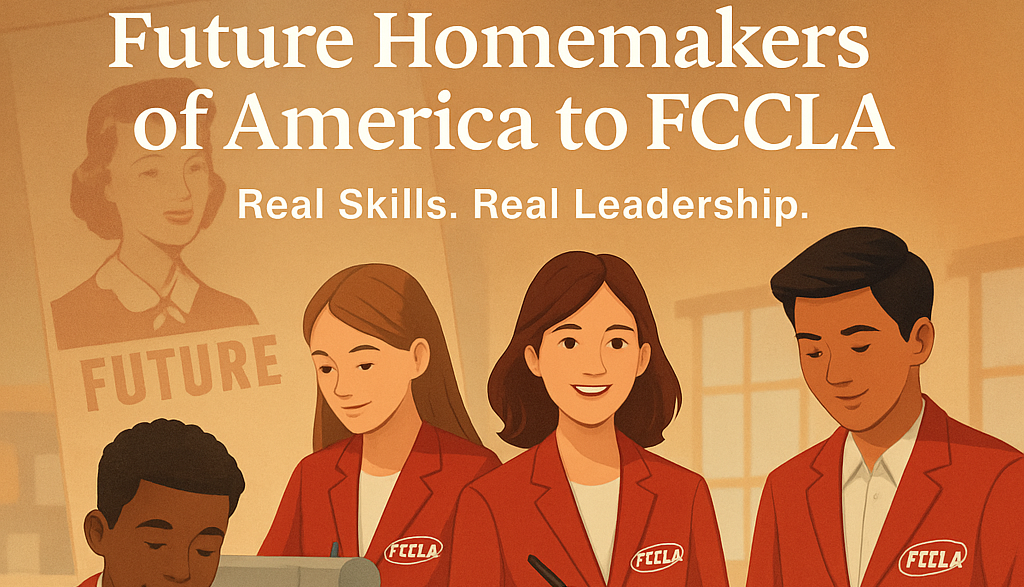Many people today have never heard the name “Future Homemakers of America.” Others remember it from school clubs, red blazers, or competitions. This group started in the mid-1900s and became one of the most important youth organizations in the country. It taught life skills, leadership, and family values to millions of students.
The name may sound old-fashioned, but the goals were bold. The group trained young people to lead strong homes and serve their communities. It helped students grow into confident adults who knew how to manage time, money, and relationships.
Over time, the group changed. It took on new challenges, updated its image, and kept its focus on family and careers. Today, it goes by a different name, but the heart of the mission stays the same.
This article will take you through the journey of Future Homemakers of America. You will learn what it was, how it grew, why it changed, and what it does now.
The Start of Something Big
Future Homemakers of America (FHA) began in 1945. It started after World War II, when people across the country were rebuilding their homes and lives. The United States Office of Education and the American Home Economics Association worked together to launch the group.
The goal was simple. Teach students-mostly girls at that time-how to build strong families. That included cooking, sewing, child care, budgeting, and problem-solving at home. The group believed good homes would create a better country.
FHA grew fast. By 1946, it had thousands of members across all 48 states. Chapters opened in high schools, and teachers led local groups. Students took part in projects, contests, and national meetings. Many wore red jackets, which became the group’s symbol.
Core Values and Mission
FHA focused on key values: leadership, community, and family strength. Members learned how to take care of others and themselves. They worked on real-world skills. They also helped local communities through food drives, safety events, and care programs.
The group was not just about housework. It gave teens a place to speak, lead, and grow. It helped members build self-worth. Public speaking, teamwork, and planning events became part of the training.
FHA welcomed all students who took home economics classes. It helped boys and girls prepare for life beyond school. It also worked closely with parents and schools to shape better futures.
Growth Through the Years
The 1950s and 60s saw major growth. FHA reached over half a million members by the mid-60s. It merged with the New Homemakers of America, a similar group for Black students in the segregated South. That made FHA more inclusive and stronger.
In 1973, boys could join FHA. Before that, the group mainly served girls. Adding boys made it more balanced and gave it fresh energy. The group also started to focus on careers, not just home life. It added new topics like health, education, and job readiness.
Through the 1980s and 90s, FHA updated its programs. It brought in modern lessons, leadership trips, and national awards. It stayed tied to schools but started acting more like a youth leadership group. Members learned how to speak up, solve problems, and serve others.
A New Name, Same Mission
In 1999, the group changed its name. “Future Homemakers of America” became “Family, Career and Community Leaders of America” (FCCLA). This new name matched the modern goals better. It showed that the group was not only about homemaking but also about building full, successful lives.
FCCLA kept the same core mission. It still helps students grow into strong, caring leaders. It still teaches life skills and promotes service. But now it also includes career training, college prep, and leadership in new fields.
The red jackets stayed. The service projects stayed. But the name and focus expanded. FCCLA wanted to fit the new century, and it did.
Modern Programs and Impact
Today, FCCLA works in thousands of schools across the U.S. It has over 200,000 members each year. It offers state and national conferences, skill-building events, and scholarships.
One key feature is the STAR Events program. STAR stands for Students Taking Action with Recognition. These events let members compete in areas like public speaking, nutrition, fashion, and entrepreneurship.
FCCLA also runs programs like STOP the Violence, Career Connection, and Families First. These projects teach safety, planning, teamwork, and health awareness. Members take real action in their schools and towns.
The group still works with schools and teachers. Most members join through classes like Family and Consumer Sciences. But the focus now includes social justice, mental health, and workplace skills.
Why It Still Matters
Some people ask if groups like FHA or FCCLA still matter. The answer is yes. In a time when many teens face stress, confusion, and pressure, FCCLA gives them structure. It helps them build trust, purpose, and confidence.
FCCLA members often say the group changed their lives. It helped them find direction, learn leadership, and serve with care. Teachers report that students who join FCCLA do better in school and later in life.
The group teaches respect, hard work, and responsibility. These are skills every person needs-at home, in a job, and in society.
Future Goals and Vision
FCCLA continues to grow. It now includes digital learning, online leadership programs, and outreach to underserved areas. The group hopes to reach more students who may feel lost or left out.
New leaders work to make FCCLA more inclusive and diverse. They want every student, no matter their background, to feel welcome. They also focus on health, safety, and strong mental habits.
FCCLA plans to lead the next generation with care, vision, and real-world tools. It keeps the spirit of FHA alive, but with a wider reach and modern goals.
Conclusion
Future Homemakers of America started with one idea-strong homes build strong communities. That idea still lives on in FCCLA. The group has changed names and added new programs, but the heart remains.
It teaches students to care, lead, and grow. It helps young people prepare for real life. It offers a safe space to learn, give back, and dream big.
Whether you remember FHA from long ago or just learned about FCCLA today, its message is clear. The future begins with strong values, kind actions, and smart choices.
FCCLA helps shape that future-one student at a time.
Frequently Asked Questions (FAQs)
What was the goal of Future Homemakers of America?
The group aimed to teach students how to build strong families and lead with purpose. It focused on real-life skills like cooking, budgeting, and child care. Members also learned leadership, respect, and responsibility.
Is Future Homemakers of America still active today?
The original group no longer exists under that name. It changed to FCCLA in 1999. The mission continues through modern programs that help students grow into strong leaders.
Who could join Future Homemakers of America?
Any student in a home economics class could join. At first, it focused on girls, but it welcomed boys in 1973. The group supported all students who wanted to lead and learn life skills.
What is FCCLA and how is it different?
FCCLA stands for Family, Career and Community Leaders of America. It keeps the same values but now includes topics like health, jobs, and public service. It reflects today’s needs while honoring the past.
How did FHA help students in real life?
Members learned how to plan, speak in public, manage time, and help others. These skills helped in school, jobs, and daily life. Many former members credit FHA for their confidence and success.
Why did the group change its name?
The name change helped show a wider focus. “Homemakers” did not fit the new goals, which included careers and community service. FCCLA gives a clearer view of what the group now offers.
Read more: Mexican Style House: Colorful, Affordable, and Naturally Cool




